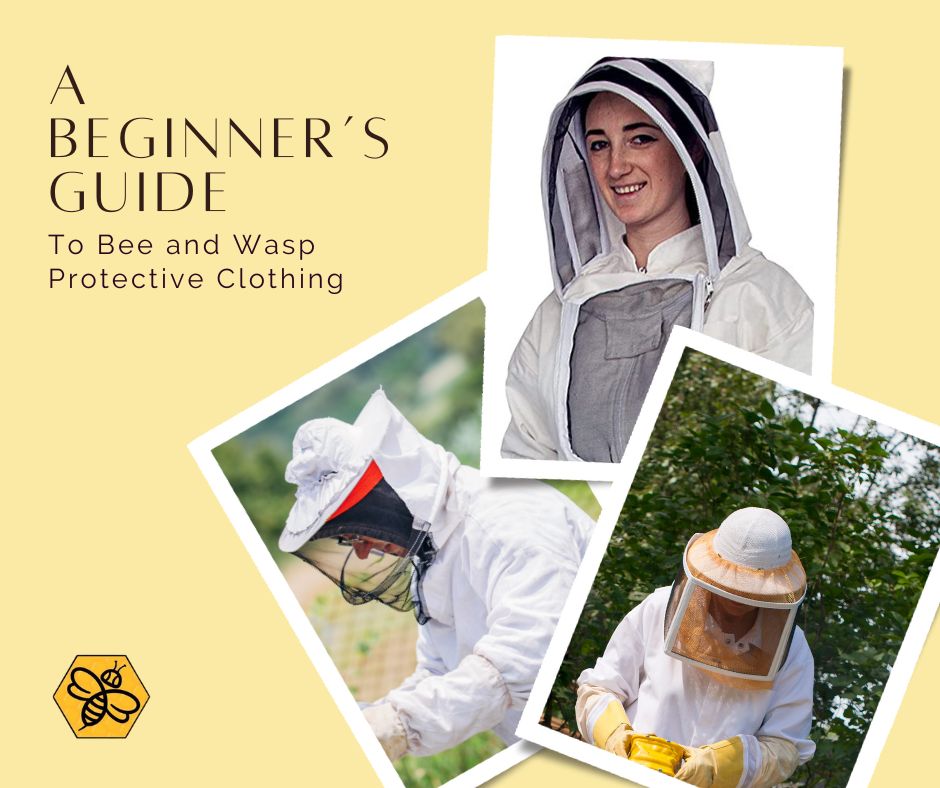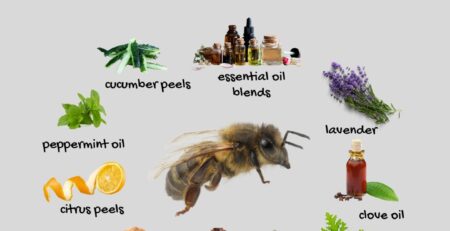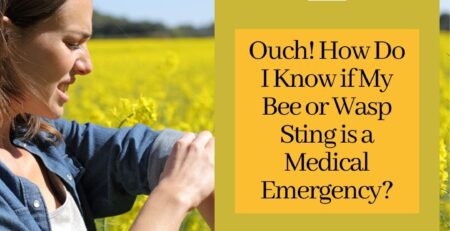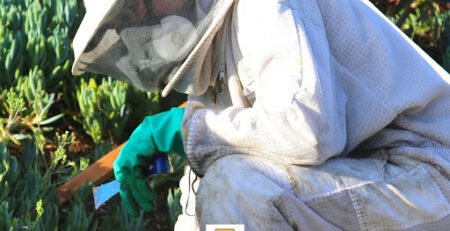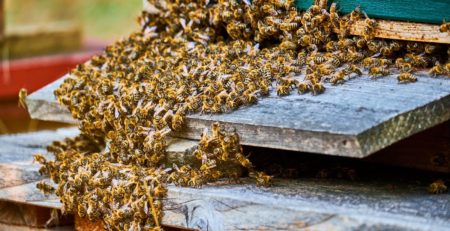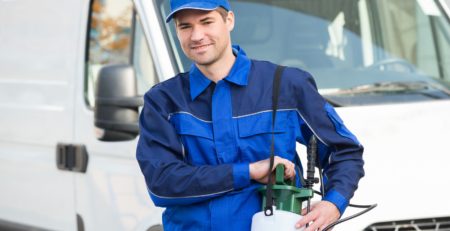A Beginner’s Guide to Bee and Wasp Protective Clothing
At The Bee Man, we value the safety of our trusted bee and wasp removal specialists. That’s why whenever we step foot on your property, we’re covered from head to toe with the best protective clothing that money can buy. That way, we can easily remove all bees and wasps from your property without being harmed and continue to service all of Orange County and most parts of Southern California.
The same protective clothing is worn by beekeepers all over the world, though this isn’t always necessary. A little fun fact for you: did you know you can totally wear regular clothes if you’re handling bees? Many beekeepers do this because it helps them to handle their bees with more skill. However, this takes years of practice and is not recommended for newbies to bees. (Or newbees? Ha!)
A good set of protective clothing will help you study bee and wasp behavior better without being bothered by the stings. Eventually, you’ll learn when they’re angry and most likely to sting, or docile and least likely to sting. Then, you can remove protective clothing and be more comfortable if you’re confident enough. But until then, it’s best to be encased in protective clothing.
Why Is It Important to Wear Protective Clothing?
Bees and wasps are known to be very protective of their territory and can sting you mercilessly if you go near their hive, even if you do it by accident! Even worse, when a bee or wasp stings you, they send signals to the rest of the colony requesting backup. If you’re not careful or not out of their territory after that first warning, you can have a whole bunch of them going after you in minutes!
Bodily reactions to bee and wasp stings vary. In mild cases, you’ll experience redness, slight swelling, and a sharp, stinging sensation that lasts a few hours. In moderate cases, a person will experience extreme redness and a larger swollen area.
In severe cases, bee and wasp stings can be deadly, especially if you’ve got an allergy to their venom. This includes intense skin reactions (e.g., hives, redness, itchiness), breathing difficulties, weakening heartbeat, nausea, dizziness, and more. According to the CDC, from 2000 to 2017, there was an average of 62 deaths due to bee and wasp stings per year.
So, it’s important to wear protective clothing around bees and wasps, especially if you’re not used to them!
What Kind of Protective Clothing Should I Wear?
There are four parts of a proper protective suit—veils, suits/jackets, gloves, and boots. Let’s separate them into components.
Veils
Veils are one of the most important parts of a suit! That’s because when bees and wasps attack you, they tend to go for the face first. That’s your most vulnerable area and hurts the most when stung. Indeed, many beekeepers forgo the use of suits or gloves but keep the veil firmly on!
There are several kinds of veils.
Round Veils
Round veils provide 360o vision and excellent ventilation. They can be worn with a hat or helmet, and when worn, they kind of look like a beach hat with mesh hanging all around it. They either come with drawstrings or elastics to be closed tightly around the neck or with zippers to attach to your bee suit/jacket.
Alexander Veils
Alexander veils look similar to round veils and provide 360o vision as well. However, they have a cloth top and an elastic headband. You don’t need to wear a hat or helmet with these, but most people do anyway.
Square Veils
Square veils are like round veils but have extra seams to make them more cube-like. These allow for more ventilation and vision. They can also be folded flat for better storage-keeping.
Fencing Veils
Fencing veils make you look like an astronaut. It provides vision for the front and sides and can be zipped easily to your bee suit/jacket. However, because there’s no mesh in the back, there’s a lack of airflow which can be tough during warmer weather.
Fencing veils are your best bet if you’re a beginner at beekeeping or bee and wasp removal.
Suits/ Jackets
Suits cover most of your body from the neck to your wrists to your ankles. A jacket, on the other hand, just covers you from the neck to the wrists. They should be paired with jeans or other pants with thick fabric.
Most suits and jackets are made of really thick cotton or a blend of cotton and polyester. It needs to be thick so the stingers can’t penetrate through easily. During the summer when it’s hotter, they can be made with polyester and vinyl to allow more ventilation and airflow.
The openings around the neck, wrists, ankles, and waist need to be secured tightly. Believe us, bees and wasps can be mighty persistent and can find the smallest holes to wiggle through! So, there need to be no spaces in between these areas. It can be secured with Velcro, elastics, or even duct tape. Some suits and jackets also come with thumb loops to prevent the sleeves from riding up.
Lastly, the zippers should be high-quality. They get used quite often, so they need to be sturdy to hold up better. Metal zippers are always the best bet, but plastic can also be good if you’re on a budget.
Gloves
Your hands will be your closest contact with the bees and wasps, so you got to keep them well-protected. However, this can be a challenge because while thick gloves protect you from pesky stingers, they prevent your hands from being agile and dexterous.
Many beekeepers and bee removals near Orange County regularly don’t wear gloves because honeycombs and tools are easier to handle. However, bees are generally less aggressive, so we really don’t recommend not wearing gloves around wasps, who are more in-your-face. Additionally, gloves need to be worn by beginners while they get used to being around these insects.
Protective gloves are usually made of cowhide or goatskin. Cowhide is the thickest and most protective, but are also the most rigid. Goatskin, on the other hand, is more supple but also thinner. Nitrile gloves are also an option because they make bees less likely to sting, though they’re not thick enough to prevent one.
Boots
Bees and wasps don’t normally go for your feet, but you’d still want proper protection if you happen to step on them, wouldn’t you?
Boots are the most versatile part of the protective set because they don’t need to be special. Plenty of boots on the market are already thick enough for bee and wasp work. Just make sure to insert your pants into the boots so they can’t make their way in there.
What Else Do I Need to Know?
Bees and wasps are persistent little buggers. They know they can’t sting you properly when you’re in your suit, so sometimes they hang around and wait until you’re removing your suit to strike! That’s why it’s important to make sure none of them are sticking to your protective gear when you’re leaving them behind. This also ensures that you’re not taking any of them into places you don’t want them to be in, like your home or office.
Conclusion
We hope this article has been informative and offers a good look into our lives as trusted Orange County and Irvine bee removal experts. We love what we do and strive to protect all homes from bee and wasp infestations. So, if you’re looking to avail any of our services, please contact us at (949) 455-0123 to get started. We offer 24/7 services around most of Southern California.
To find more about our work, please visit our website here.

